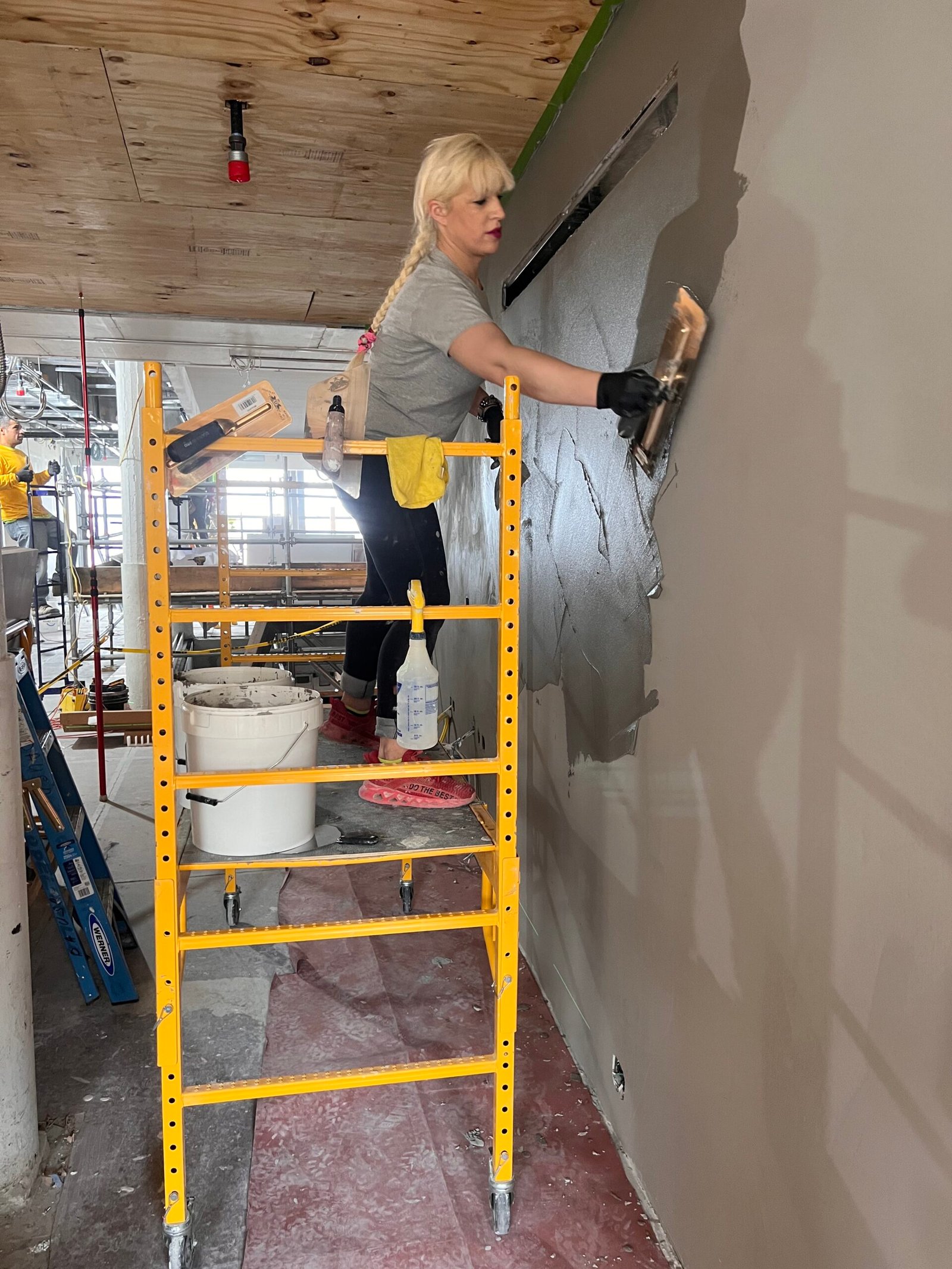Tadelakt plaster is quickly becoming a popular choice for homeowners looking to add beauty and sustainability to their bathrooms. But what exactly is Tadelakt, and why should you consider it over other traditional bathroom finishes? In this article, we’ll explore why Tadelakt is a standout in the world of eco-friendly materials and how it compares to other options like Venetian plaster.
Not only is Tadelakt plaster beautiful, but it’s also a long-lasting, environmentally friendly option for bathroom renovations. Whether you’re in New York or elsewhere in the USA, choosing sustainable options for your home is more important than ever, and Tadelakt could be the perfect solution for your next bathroom project.
What is Tadelakt Plaster?
Tadelakt plaster is a luxurious, polished plaster finish that originates from Morocco. It’s typically made from natural lime, which gives it a smooth, shiny surface. Unlike regular plasters, Tadelakt has been used for centuries in the walls of Moroccan palaces and bathrooms. The traditional technique involves a special method of applying the plaster and then polishing it to create a lustrous, stone-like finish.
One key feature of Tadelakt is its ability to resist moisture, making it an ideal choice for bathrooms. It’s a breathable material that helps control humidity levels in the space, preventing mold growth and contributing to better indoor air quality.
Why Choose Eco-Friendly Tadelakt Plaster for Your Bathroom?
As homeowners become more environmentally conscious, choosing eco-friendly materials like Tadelakt is becoming a common practice. Tadelakt offers numerous benefits, especially in bathroom spaces where moisture can cause damage over time.
Sustainable Material: Tadelakt is made from lime, a natural, non-toxic material that doesn’t require harmful chemicals. This makes it a healthier option for your home and the planet.
Durability: Once applied, Tadelakt is incredibly durable. Its polished finish can last for years without showing signs of wear, unlike some synthetic finishes that may chip or peel.
Aesthetic Appeal: The smooth, shiny finish of Tadelakt gives any bathroom a high-end, spa-like feel. It’s elegant and timeless—creating a space you’ll love to use every day.
How Eco-Friendly Tadelakt Works in the Bathroom
The bathroom is one of the most demanding environments for building materials. Between heat, moisture, and everyday use, it’s important to choose materials that can stand the test of time. Tadelakt is naturally resistant to water, making it an ideal choice for wet areas such as showers, sinks, and tubs.
Its unique composition also allows the material to breathe. This means it helps maintain a healthy level of humidity in the bathroom, preventing mold and mildew growth, which can often be an issue in damp, closed spaces.
In addition to its functionality, Tadelakt requires very little maintenance. With just a simple wipe-down, you can keep the plaster looking fresh. However, its resilience doesn’t mean it’s hard to repair; small chips or cracks are easy to fix, unlike some other bathroom finishes, such as traditional tiles or drywall, which can be more difficult to maintain.
Eco-Friendly Tadelakt vs. Other Bathroom Wall Finishes
When it comes to bathroom finishes, homeowners have many choices. Popular options include Venetian plaster, ceramic tiles, paint, and standard drywall. However, Tadelakt has several advantages that make it stand out from the rest:
Venetian Plaster: Known for its smooth, shiny finish, Venetian plaster has many similarities to Tadelakt. In fact, it’s often used interchangeably in the design world. However, while Venetian plaster is beautiful, it’s typically not as moisture-resistant as Tadelakt, especially when applied in wet areas like showers. Moreover, the application process for Venetian plaster can be more complex, requiring highly skilled craftsmen.
Ceramic Tiles: Tiles are a common bathroom finish due to their easy maintenance and moisture resistance. However, tiles can be cold, hard, and often lack the warmth and elegance that Tadelakt provides. Tiles also involve grout lines that can collect dirt and grime, while Tadelakt offers a smooth, continuous surface.
Paint: While paint is an inexpensive option, it doesn’t offer the same durability or moisture resistance as Tadelakt. Over time, paint can peel or discolor, especially in areas like the bathroom.
In comparison, Italian Venetian plaster and Polished Venetian plaster both have aesthetic appeal but often lack the breathability and eco-friendly composition of Tadelakt.
How to Apply Eco-Friendly Tadelakt Plaster in Your Bathroom
Applying Tadelakt to your bathroom walls might seem like a daunting task, but with the right tools and technique, it can be done successfully. Here’s a step-by-step guide to help you get started:
Preparation: Start by ensuring your walls are clean, dry, and free from any dust or grease. Tadelakt works best on smooth surfaces, so you may need to prepare the walls with a base coat.
Mixing the Plaster: Tadelakt is mixed with water and a special soap solution that helps achieve its shiny finish. Follow the manufacturer’s instructions carefully for the right proportions.
Application: Use a trowel to apply the plaster in thin layers, smoothing it out as you go. It’s important to work in small sections to avoid uneven finishes.
Polishing: Once the plaster is applied, use a polished stone or trowel to burnish the surface, creating a glossy finish.
Sealing: To enhance the water resistance of the plaster, a natural, eco-friendly wax or oil is applied to the surface.
Top Benefits of Eco-Friendly Tadelakt for Bathroom Renovations
Sustainability: Tadelakt is made from natural materials, reducing its environmental impact. Choosing this material means you’re making a more sustainable choice for your bathroom renovation.
Aesthetic Appeal: The luxurious, polished finish gives your bathroom a sophisticated look that elevates the overall design.
Durability: Tadelakt is resistant to wear and tear, making it ideal for high-traffic areas like the bathroom.
Easy Maintenance: Unlike tiles or painted surfaces, Tadelakt requires minimal maintenance and can be easily cleaned or repaired.
FAQs About Eco-Friendly Tadelakt Plaster for Bathrooms
Q: What is the difference between Tadelakt and Venetian plaster?
A: Both materials have a smooth, shiny finish, but Tadelakt is more moisture-resistant and breathable, making it a better choice for bathrooms.
Q: How long does Tadelakt last in a bathroom?
A: With proper application and care, Tadelakt can last for decades in a bathroom setting, with minimal signs of wear.
Q: Can Tadelakt be used on floors as well as walls?
A: Tadelakt is primarily used on walls, especially in wet areas, but it can be applied to floors in certain conditions with the right techniques.
Q: How do you clean and maintain Tadelakt plaster?
A: Regular cleaning with a damp cloth is enough to maintain its appearance. For repairs, simply apply a new layer of plaster to any damaged areas.
Final Thoughts On Why Eco-Friendly Tadelakt is the Future of Bathroom Design
Eco-friendly materials like Tadelakt provide a beautiful, sustainable solution for bathroom renovations. With its durability, aesthetic appeal, and environmentally friendly composition, Tadelakt is a clear winner over other finishes like Venetian plaster or tiles. If you’re considering a bathroom renovation, Tadelakt could be the perfect choice for your New York home.

